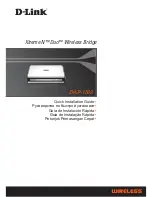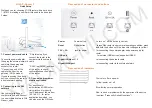
6
|
Rev 01|March 2022
n
Cat5E or better UTP cable with network access
Optional items
n
A compatible power adapter with cord
n
A compatible PoE midspan injector with power cord
n
An AP-CBL-SERU console cable
n
An AP-MOD-SERU console module
Also, make sure at least one of the following network services is supported:
n
Aruba Discovery Protocol (ADP)
n
DNS server with an “A” record
n
DHCP Server with vendor specific options
Aruba, in compliance with governmental requirements, has designed the 650 Series access points so that only
authorized network administrators can change configuration settings. For more information about AP configuration,
refer to the
.
If a power adapter other than the Aruba-approved adapter is used in the US or Canada, it should be NRTL listed, with
an output rated 12V DC, minimum 4A, marked “LPS” and “Class 2,” and suitable for plugging into a standard power
receptacle in the US and Canada
.
Identifying Specific Installation Locations
Use the access point placement map generated by Aruba 650 Series RF Plan software application to determine
the proper installation location(s). Each location should be as close as possible to the center of the intended
coverage area and should be free from obstructions or obvious sources of interference. These RF
absorbers/reflectors/interference sources will impact RF propagation and should be accounted for during the
planning phase and adjusted for in RF plan.
Identifying Known RF Absorbers/Reflectors/Interference Sources
Identifying known RF absorbers, reflectors, and interference sources while in the field during the installation
phase is critical. Make sure that these sources are taken into consideration when you attach an access point to
its fixed location.
RF absorbers include:
n
Cement/concrete—Old concrete has high levels of water dissipation, which dries out the concrete, allowing
for potential RF propagation. New concrete has high levels of water concentration in the concrete, blocking
RF signals.
n
Natural Items—Fish tanks, water fountains, ponds, and trees
n
Brick
RF reflectors include:
n
Metal Objects—Metal pans between floors, rebar, fire doors, air conditioning/heating ducts, mesh windows,
blinds, chain link fences (depending on aperture size), refrigerators, racks, shelves, and filing cabinets.
n
Do not place an access point between two air conditioning/heating ducts. Make sure that access points are
placed below ducts to avoid RF disturbances.
RF interference sources include:
n
Microwave ovens and other 2.4 or 5 GHz objects (such as cordless phones)
n
Cordless headset such as those used in call centers or lunch rooms
































